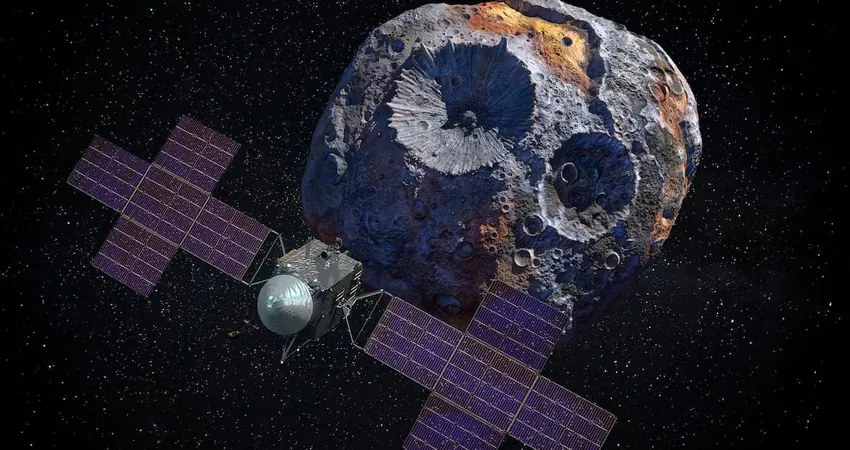
Unlocking the Universe: The Groundbreaking Concept of Asteroid Mining
2025-06-30
Author: John Tan
Imagine a world where access to rare earth metals is virtually unlimited, fueling everything from electric vehicles to cutting-edge technology. Welcome to the pioneering concept of asteroid mining—a visionary endeavor aimed at extracting valuable resources from asteroids that are located hundreds of thousands of miles away.
Asteroids are treasure troves, packed with essential materials like precious metals and frozen water that could revolutionize space exploration. Unlike terrestrial mining, asteroid extraction promises to minimize environmental damage while alleviating supply chain issues here on Earth. The water from these celestial bodies could even be transformed into rocket fuel, enabling us to venture deeper into space than ever before.
What Is Asteroid Mining?
Asteroid mining refers to the extraction of metals, minerals, and other resources from asteroids. Scientists classify these space rocks into three primary categories: C-type (carbon-rich), S-type (silicate rocks rich in iron and nickel), and M-type (metallic, containing valuable metals like platinum). While some companies are honing in on metallic asteroids for their precious metals, others are eyeing C-type asteroids for their water and gases, which could serve as rocket fuel.
Though no one has successfully mined an asteroid yet, various startups are racing to change that. With an array of ambitious claims and innovative projects on the horizon, the emergence of a new space economy may be closer than we think.
Why Go Galactic?
Why mine asteroids when Earth is brimming with mines? For starters, demand for precious metals like platinum and cobalt is soaring, especially with the surge in green technology. Asteroids may hold the key to reducing our dependence on Earth-based mining, which often devastates ecosystems and pollutes our environment.
Furthermore, companies are exploring in-situ resource utilization—collecting and utilizing resources directly from asteroids. This groundbreaking approach could pave the way for a self-sustaining space economy, reducing mission costs and accelerating space travel.
A Brief History of Asteroid Mining
Once a niche topic in science fiction, asteroid mining took a step towards reality in 2012 with the launch of Planetary Resources, backed by tech giants like Larry Page. Despite initial setbacks, the field has gained momentum, with startups now leveraging affordable launch technologies to bring their concepts to life.
Who's in the Race?
New players are emerging, like AstroForge, which aims to use cutting-edge laser technology for extracting platinum-group metals. Meanwhile, TransAstra focuses on capturing asteroids in specialized bags to extract vital gases and water, thus fueling space missions and launching a new era of interstellar exploration.
The Road Ahead: Risks and Challenges
Asteroid mining may sound exciting, but it's fraught with challenges. Financial constraints loom large, as the costs of missions can easily escalate into the millions. Additionally, while space mining promises to alleviate earthly environmental concerns, rocket launches still produce pollution and the risk of creating hazardous space debris is a real threat to future missions.
Legal ambiguities also plague the industry, with international laws struggling to keep pace with technological advancements. Questions surrounding ownership and resource extraction rights remain unresolved, causing potential disputes among nations.
What’s Next?
Companies targeting asteroids are devising logistics to overcome extraction hurdles. Near-Earth asteroids, identified by advanced telescopes, offer a promising target, but complex challenges like zero gravity complicate extraction processes. Innovative techniques, such as robotic mining and on-site resource processing, are being developed to make asteroid mining a tangible reality.
As we stand on the brink of this cosmic frontier, asteroid mining holds the promise not just of wealth, but of a new age in human civilization, unlocking resources that may one day lead us deeper into the stars.


 Brasil (PT)
Brasil (PT)
 Canada (EN)
Canada (EN)
 Chile (ES)
Chile (ES)
 Česko (CS)
Česko (CS)
 대한민국 (KO)
대한민국 (KO)
 España (ES)
España (ES)
 France (FR)
France (FR)
 Hong Kong (EN)
Hong Kong (EN)
 Italia (IT)
Italia (IT)
 日本 (JA)
日本 (JA)
 Magyarország (HU)
Magyarország (HU)
 Norge (NO)
Norge (NO)
 Polska (PL)
Polska (PL)
 Schweiz (DE)
Schweiz (DE)
 Singapore (EN)
Singapore (EN)
 Sverige (SV)
Sverige (SV)
 Suomi (FI)
Suomi (FI)
 Türkiye (TR)
Türkiye (TR)
 الإمارات العربية المتحدة (AR)
الإمارات العربية المتحدة (AR)